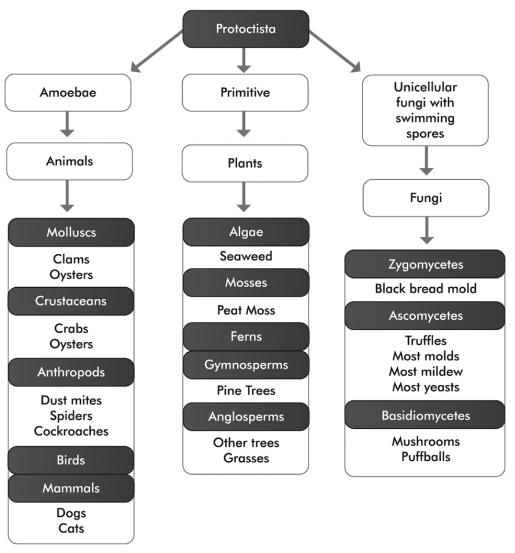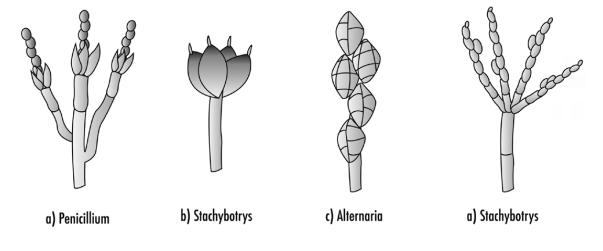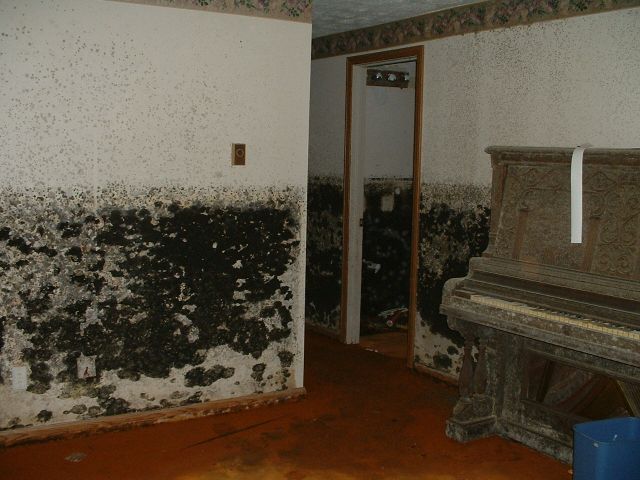Mold Is Fungi
Molds are organisms that are found indoors and outdoors. They are part of the natural environment and play an important role in our ecological system by breaking down and digesting organic material. Molds are neither plants nor animals. They are part of the kingdom Fungi.

The diagram above demonstrates the role of fungi in relation to other living organisms. Fungi are not plants. Fungi are not animals. Fungi belong to a taxonomic classification, or kingdom, of their own. Plants convert carbon dioxide directly into carbohydrates for food. Animals and fungi must find complex carbon in the environment for food. While animals ingest the food and degrade it internally, fungi excrete chemicals (enzymes) into the environment that degrade the complex carbon into a soluble form.
Fungi do not make their own food the way that green plants do. Fungi get nourishment from other living organisms. The main role of fungi in the ecosystem is to break down dead materials, such as fallen leaves, trees, insects and animal carcasses. The same enzymes that assist fungi in breaking down dead materials are what help fungi to damage wooden components in a building. Molds can damage food, stored goods, and building materials of houses.
Yeast, mold, mildew and mushrooms are common forms of fungi. Mold is essentially a description of fungi that grows on surfaces, such as the black substance on a moldy shower wall. Mold and mildew often refer to the same type of fungi. All mold is fungi, but not all fungi is mold.
Molds grow in many colors, including white. “Black mold” is not a species or specific kind of mold, and neither is “toxic mold.” Sometimes the news media use the terms “toxic mold” and “black mold” to refer to molds that may produce mycotoxins, or for a specific mold known as Stachybotrys chartarum. Molds that produce mycotoxins are often referred to as toxigenic fungi.
Molds can multiply by producing microscopic spores (2 to 100 microns [μm] in diameter), similar
to the seeds produced by plants. Many spores are so small, they easily float through the air and can be carried for great distances by even the gentlest breeze. The number of mold spores suspended in indoor and outdoor air fluctuates from season to season, day to day, and even hour to hour.
No one knows how many species of fungi exist, but estimates range from the tens of thousands to perhaps 300,000 or more. Some of the more common indoor molds are Penicillium, Aspergillus, Cladosporium and Alternaria.

Mold Is Everywhere
Mold spores are ubiquitous; they are found both indoors and outdoors. Mold spores cannot be eliminated from indoor environments. Some mold spores will be found floating through the air and on settled dust; however, they will not grow if moisture is not present.
Why Be Concerned?
Mold is not usually a problem indoors—unless mold spores land on a wet or damp spot and begin growing. As molds grow, they digest whatever they are growing on. Unchecked mold growth can damage buildings and furnishings; molds can rot wood, damage drywall, and eventually cause structural damage to buildings. Mold can cause cosmetic damage, such as stains, to furnishings. The potential human health effects of mold are also a concern. It is important, therefore, to prevent mold from growing indoors.

Discovering fungi in the indoor environment raises three major concerns:
- the potential negative health effects of exposure to fungi and their byproducts;
- the effects of fungal contamination on the structural integrity of a building; and
- the negative aesthetic effects fungi can produce both visually and on the human olfactory system.
Although the issue of whether exposure to indoor fungi causes adverse health effects is controversial, there is no doubt that a seriously mold-contaminated building can suffer structural damage, and that a foul-smelling, fungus-filled building is aesthetically unpleasing. Controversies about health effects aside, the latter two reasons are sufficient to merit a Complete Mold Inspection and remediation when an environment is found to have fungal contamination.
People who have concerns about structural damage or the aesthetic effects of indoor fungi should seek the services of an IAC2-Certified Mold Inspector. People who have concerns about the health effects of mold exposure should seek the advice of a healthcare professional.

